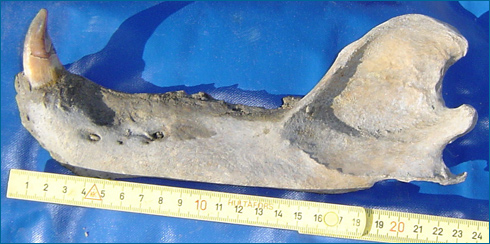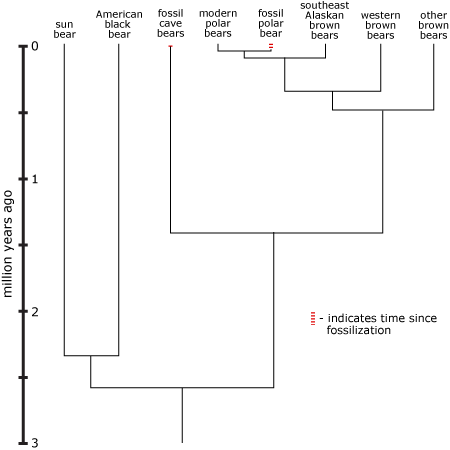
As the fuzzy and ferocious poster child for climate change issues, polar bears get plenty of press, whether it’s coverage of something as simple as the birth of a cub at a zoo or as political as a rejected ban on trading polar bear parts. Last month, however, saw a polar bear story of a different ilk — a story about the bears’ evolutionary past that has implications for their evolutionary future. Polar bears, it turns out, may have evolved surprisingly quickly in response to past climactic changes. Here, we’ll examine the different lines of evidence that led scientists to this conclusion.
Where's the evolution?
In 2004, researchers discovered a polar bear fossil preserved in Norwegian coastal cliffs. It was the lower left portion of the jaw, still containing a tooth. And though this might not sound like much information to go on, the single fossil would turn out to have a lot to say about polar bear evolution.
Based on the jawbone’s shape, scientists were confident that it belonged to an adult male polar bear. The rock layers in which it was embedded, along with other dating techniques, suggest that it is 110,000 to 130,000 years old — older than any other known polar bear fossils. This date alone is interesting because previous estimates for the origin of polar bears have ranged from 70,000 to more than a million years ago. But, based on the new fossil’s age, we can infer that the polar bear lineage must be more than 110,000 years old. The anatomy and rocks in which the jawbone was preserved provided useful information — but the fossil had an even more powerful line of evidence: DNA.
DNA breaks down over time, but new techniques allow scientists to pull these fragmented bits of DNA out of some well-preserved fossils, copy the pieces, and reassemble them into a very good estimate of the original genetic sequence. An international group of scientists used these techniques on DNA from the polar bear jawbone and announced their findings last month. They had reconstructed the sequence of the bear’s mitochondrial DNA — a short loop of DNA that is housed in the cell’s “powerhouse” organelles, mitochondria. The ancient mitochondrial DNA was easier for the scientists to work with than the bear’s main genome (housed in the nucleus), because each cell contains many copies of its mitochondrial DNA and only one copy of its nuclear genome.
The researchers compared the fossil’s DNA sequence to those from different species of modern bears and from extinct cave bears. They used these sequences to reconstruct the animals’ family tree. As expected, the modern and ancient polar bear DNA formed a tight group, a clade — and that clade was most closely related to the brown bears of Southeast Alaska.

What is a polar bear?
Evolutionarily speaking, polar bears (Ursus maritimus) are brown bears (Ursus arctos). That might seem counterintuitive, but modern biologists classify species according to their evolutionary history. Organisms that are more closely related are grouped together. In this system, only clades — groups of organisms that contain all the descendents of an ancestor — are named. When we look at the family tree of bears, we can see that not only are polar bears most closely related to brown bears, but they actually fall within the brown bear clade. There is no clade that includes all the brown bears and excludes the polar bears. From an evolutionary perspective, polar bears are simply a unique and highly specialized sort of brown bear!
The surprise came when the researchers used two different lines of reasoning to learn more about the relationship between the ancestral polar bear and the fossil. First, they used the DNA sequences to extrapolate back to the sequence that the ancestor of polar bears and brown bears would likely have carried. The fossil specimen’s DNA was extremely similar to the likely sequence of the polar bear ancestor! Second, they used molecular clocks to estimate the date of the split between polar bears and brown bears. Molecular clocks are stretches of DNA that evolve at a fairly regular pace can be used as evolutionary tape measures to estimate how long ago different events happened. The more differences a clock-like stretch of DNA has accumulated since a divergence, the more time has probably passed since that divergence. The differences among the bears’ sequences pointed to a split between polar bears and brown bears just 150,000 years ago. All this means that the fossil (which may be as many as 130,000 years old) likely represents one of the very earliest members of the polar bear lineage!
Having already investigated the fossil’s anatomy, stratigraphy, and mitochondrial DNA (as well as the molecular clock in that DNA), the team of researchers studied one more line of evidence unearthed with the fossil: the atoms that compose the tooth embedded in the jawbone. An organisms’ diet strongly influences the sort of atoms that are deposited in its body — specifically the ratios of atoms with different numbers of neutrons. By studying the carbon and nitrogen in the bear’s tooth, the researchers discovered ratios that were exactly what we’d expect to observe of a bear that gets its nutrition from seafood! Just 20,000 years or so after they diverged from forest-dwelling brown bears, polar bears had already evolved their distinctive marine lifestyle. For a large mammal, that’s evolution at breakneck speed!
This rapid pace of polar bear evolution may have been related to changes in the climate going on at the time. The polar bear and brown bear lineage split during a glacial age. This may have provided the ecological setting for the evolution of the seafood eating, sea ice-loving polar bear lifestyle. The newly formed polar bear lineage survived one warm interglacial period before being plunged back into another glacial age.
Now of course, the planet is warming again — this time due to human actions. Will polar bears survive? The answer is not clear, but the new research does shed some light on the issue. We now know that polar bears have evolved surprisingly quickly in the past. However, today, the Earth is heating up much faster than it ever has before — and the unprecedented pace of that change makes it difficult for slow reproducing organisms like polar bears to evolve to keep up. One thing is for certain: knowing more about how polar bears have responded to climate change in their evolutionary past can help us figure out how to help them survive into the future.
Primary literature:
- Lindqvist, C., Schuster, S. C., Sun, Y., Talbot, S. L., Qi, J., Ratan, A., . . . Wiig, Ø. (2010). Complete mitochondrial genome of a Pleistocene jawbone unveils the origin of polar bear. Proceedings of the National Academy of Sciences, USA. 107 (11): 5053-5057. Read it »
- Ingolfsson, Ó., and Wiig, Ø. (2008). Late Pleistocene fossil find in Svalbard: the oldest remains of a polar bear (Ursus maritimus Phipps, 1744) ever discovered. Polar Research. 28: 455-462. Read it »
News articles:
- A quick summary of the research from Wired
- A thorough explanation of the research from Scientific American
Understanding Evolution resources:
- The basics of building and using evolutionary trees
- A quick tutorial on molecular clocks
- A news brief on how organisms have evolved in response to global warming
Background information from Understanding Global Change:
- List at least four different lines of evidence that the researchers were able to glean from the polar bear fossil. For each, briefly describe what that line of evidence suggested about the fossil or polar bear evolution.
- Read this article on how organisms are changing in response to climate change. Does the conclusion of that article — regarding polar bears and climate change — conflict with the conclusion of the article above? Why or why not?
- Study the evolutionary tree and the boxed text in the article above. Cave bears — like polar bears — are closely related to brown bears. Are cave bears members of the brown bear clade? Why or why not?
- Review this page on parsimony. The researchers used the principle of parsimony, along with mitochondrial DNA sequences, to construct the tree shown in the article above. Based on the principle of parsimony, what would make the researchers prefer this tree to other possible trees? Make sure that your answer references the DNA sequences.
- Advanced: Study this figure from the original journal article:

It shows mitochondrial genome sequence variation among different bears. For each sequence, the differences between it and a reference polar bear sequence (shown at the bottom) are marked with black lines. Stretches of DNA with different functions are indicated by the color of the reference sequence. The sequence from the polar bear fossil is labeled in red font.
-
- Which polar bear sequence is most different from the polar bear reference sequence? What sort of evolutionary explanation could you give for why this sequence is most different?
- Based on these data, do you think that some brown bears are more closely related to polar bears than other brown bears? Explain your reasoning.
- Based on the polar bear sequences alone, does it seems that some regions of the DNA are more likely to show variation than others? If not, explain how you came to that conclusion. If so, which regions show the most variation, and how might you explain this in functional or evolutionary terms?
- Teach about evolutionary trees: In this web-based module for grades 6-12, students are introduced to cladistics, which organizes living things by common ancestry and evolutionary relationships.
- Teach about mitochondrial DNA and molecular clocks: This interactive and engaging web activity, for grades 9-12, compares the number of mutations in the mitochondrial genomes of primates to determine ancestry and relatedness.
- Teach about evolution and climate change: This article for grades 9-12 follows scientist Jennifer McElwain as she studies the fossil record in order to learn more about how global warming has affected life on Earth in the past and how it might affect life on Earth in the future. This article comes with a set of discussion questions for use in the classroom.
- Eilperin, J. (2010, March 19). Global conference rejects bans on trade in bluefin tuna, polar bear. The Washington Post. Retrieved April 2, 2010 from The Washington Post.
- Lindqvist, C., Schuster, S. C., Sun, Y., Talbot, S. L., Qi, J., Ratan, A., . . . Wiig, Ø. (2010). Complete mitochondrial genome of a Pleistocene jawbone unveils the origin of polar bear. Proceedings of the National Academy of Sciences, USA. 107 (11): 5053-5057.
- Ingólfsson, Ó., and Wiig, Ø. (2008). Late Pleistocene fossil find in Svalbard: the oldest remains of a polar bear (Ursus maritimus Phipps, 1744) ever discovered. Polar Research. 28: 455-462.
